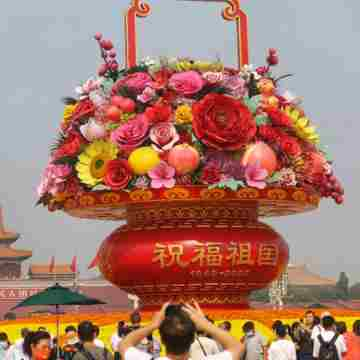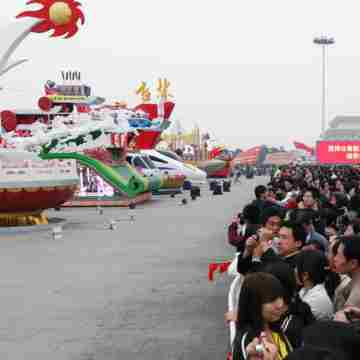National Day of China, celebrated every year on October 1st, stands as a monumental occasion in the nation’s history. It is a day of great importance and significance, marking the founding of the People’s Republic of China. This public holiday, which extends over three days, is not just an ordinary celebration; it’s a nationwide extravaganza that captivates the hearts of millions.
At the heart of this celebration lies the concept of the “Golden Week.” This unique phenomenon has transformed China’s National Day into the second-largest holiday period in the country. As we delve into this article, we’ll unravel the rich history behind this holiday, explore the traditions that make it special, and understand why the “Golden Week” holds a cherished place in Chinese culture. Join us on this journey as we discover the vibrant tapestry of China’s National Day and the phenomenon of the “Golden Week.”
History of National Day of China
China’s National Day, celebrated with great pomp and pride on October 1st each year, carries with it a profound historical legacy. To truly appreciate the significance of this day, let’s delve into the annals of China’s history:
The Road to Liberation (1949): The foundation of the People’s Republic of China was laid on this very day in 1949 when Chairman Mao Zedong stood before the iconic Tiananmen Gate and declared the birth of a new nation. This pivotal moment marked the end of a long and bitter civil war between the Chinese government and the Chinese Communist Party under Mao’s leadership. It was a turning point that reshaped the course of China’s history.
Evolution of Celebrations: In the early years following the founding of the People’s Republic, National Day was celebrated with grand rallies, reflecting the sheer scale and magnitude of the occasion. These gatherings echoed with patriotic fervor and were instrumental in forging a sense of unity among the Chinese people.
Simplicity and Personal Touch (1960-1970): However, as China evolved, so did the nature of its National Day celebrations. In the 1960s, a shift toward simpler, more personal observances emerged. Military parades were replaced by a more intimate form of commemoration, reflecting China’s commitment to communist principles while emphasizing the importance of the individual.

Memorable Exceptions (1984 and 1999): While grand celebrations became a rarity, there were exceptional moments in 1984 and 1999 when the nation came together in full force. These celebrations, marking the 35th and 50th anniversaries of the Chinese Communist Party’s founding, respectively, stood as reminders of the enduring spirit of the Chinese people.
National Day Honors List: In recent years, another layer of significance has been added to the National Day celebrations through the “National Day Honors List.” This prestigious list, published by the State Council, acknowledges and honors the contributions of Chinese citizens who have excelled in fields such as charity, economics, sports, diplomacy, and cultural promotion. These remarkable individuals are awarded national medals and honorary titles by the President and General Secretary in a special ceremony just days before National Day. This gesture serves as a testament to the nation’s gratitude and recognition of their outstanding achievements.
National Day of China Timeline
Echoes of the Past, Resonance in the Present
China’s National Day on October 1st is not just a celebration of the modern nation but a reflection of the rich tapestry of its history. Let’s embark on a journey through time and explore key milestones that have left an indelible mark on China’s history, offering valuable insights into the significance of this celebrated day:
The Age of Invention (1088): Our journey began in the Song Dynasty, with the Chinese invention of printing and the first use of paper money. While these innovations transformed society in their time, they continue to resonate in modern China as a testament to the nation’s rich cultural and technological heritage. Printing, in particular, played a pivotal role in the dissemination of knowledge and culture.
Opium War (1840): The Opium War marked a dark chapter in China’s history when the nation lost the war to the British, resulting in the importation of opium. This event, though fraught with adversity, played a crucial role in shaping China’s determination to regain its sovereignty and independence. The memory of this struggle continues to fuel China’s resilience and commitment to its national identity.

End of the Empire (1912): In 1912, the Qing Empire gave way to the establishment of the Republic of China. This momentous shift marked the end of dynastic rule and the birth of a new era in Chinese history. It laid the foundation for the modern Chinese state and its ongoing quest for progress and development.
Olympics (2008): The year 2008 saw China hosting the Summer Olympics for the first time in Beijing, a historic event that showcased the nation’s prowess on the global stage. This moment not only signaled China’s emergence as a global superpower but also added a contemporary layer of significance to National Day. It highlighted China’s commitment to openness, cooperation, and excellence.
How to Observe the National Day of China
Embracing the Spirit of Celebration
China’s National Day on October 1st is not only a day for the people of China to rejoice but also an occasion for people around the world to join in the celebration. Here are some delightful ways to observe this special day and immerse yourself in the festivities:
Wish Your Chinese Friends and Coworkers: Extend your warm wishes for a happy National Day of China to your Chinese friends and coworkers. A heartfelt message or greeting can go a long way in sharing the joy of this significant day with those who cherish it. If you have a Chinese coworker, consider bringing them a small gift as a gesture of goodwill and appreciation.
Visit Chinatown: No celebration of National Day of China is complete without a visit to your local Chinatown. These vibrant neighborhoods come alive with an air of festivity during this time, offering a unique glimpse into Chinese culture and traditions. The streets are adorned with colorful decorations, and you can witness traditional performances, parades, and cultural displays. The atmosphere is electric, and you’ll find yourself immersed in the heart of China’s rich heritage.
Enjoy Chinese Food: One of the most delightful ways to celebrate National Day is by treating yourself to a feast of Chinese cuisine. Whether you order from your favorite Chinese restaurant or venture out to dine in, the flavors of China await your taste buds. Here are some traditional dishes to savor:
Peking Duck: Indulge in the succulent delight of Peking Duck, known for its crispy skin and tender meat. It’s a dish that embodies the essence of Chinese culinary artistry.
Dim Sum: Delight in an assortment of bite-sized delicacies served in bamboo steamers. From dumplings to buns, dim sum offers a tantalizing array of flavors.
Hot Pot: Warm your senses with a communal hot pot meal. You’ll have the opportunity to cook an assortment of meats, vegetables, and noodles in a flavorful broth, creating a dining experience that’s both delicious and interactive.
Mapo Tofu: Savor the spicy and flavorful Mapo Tofu, a classic Sichuan dish known for its bold and aromatic taste.
Spring Rolls: Enjoy the crispy goodness of spring rolls, a popular appetizer that’s perfect for sharing.
These culinary delights not only tickle your taste buds but also pay homage to the diversity of Chinese cuisine. National Day is a celebration of China’s rich food culture, and indulging in these dishes is a wonderful way to join in the festivities.
5 Interesting Facts About China
China, with its rich history and diverse culture, never ceases to amaze. As we celebrate National Day, let’s uncover five intriguing facts about this vast and vibrant nation:
The Most Populated Country in the World: China’s sheer population is nothing short of astounding. With nearly 1.4 billion people, it holds the title of the world’s most populous country. The scale of its society and the diversity of its people are a testament to China’s unique character.
Mandarin is Not the Only Language: While Mandarin Chinese is the most widely spoken language, China is a linguistic mosaic. There are numerous other Chinese languages and dialects spoken across the country, including Yue, Wu, Minbei, Minnan, Xiang, Gan, and Hakka. This linguistic diversity reflects the nation’s cultural richness.
Elderly Rights Law: China takes care of its elderly population through the Elderly Rights Law. This law mandates that adult children are legally required to visit and support their parents aged 60 and above. It reflects China’s deep-rooted cultural values of respect for elders and family bonds.
Fortune Cookies Did Not Originate in China: Despite their association with Chinese cuisine, fortune cookies are not a Chinese invention. Surprisingly, they were actually created in San Francisco, USA. These crispy treats, often containing a small message of wisdom or prophecy, have become a staple in Chinese-American restaurants.
Extensive Railway System: China boasts one of the most extensive and advanced railway systems globally, with over 25,000 kilometers of high-speed railways. This impressive network can loop around the Earth two times! It not only facilitates efficient transportation within the country but also showcases China’s commitment to modern infrastructure.
Why the National Day of China Is Important
Celebrating China’s Legacy, Unity, and Global Significance
China’s National Day celebrated with fervor and pride on October 1st, holds a profound significance that transcends borders and resonates with people worldwide. Here are key reasons why this day is of paramount importance:
Appreciating Chinese Culture, People, and History: National Day provides a poignant moment to celebrate and appreciate the rich tapestry of Chinese culture, the resilience of its people, and the depth of its history. It offers a glimpse into China’s ancient traditions, artistic achievements, and culinary delights. By observing this day, individuals from all walks of life can come to understand and cherish the diverse facets of China’s heritage.
A Milestone in Global Politics: The founding of the People’s Republic of China on October 1, 1949, was not merely a national event; it reverberated across the globe. It marked a historic moment in global politics when China embraced a communist government. This transition had far-reaching implications for international relations, shaping the course of the Cold War and influencing the dynamics of the world stage. National Day serves as a reminder of this pivotal chapter in modern history and the enduring impact it has had on global politics.
Promoting Inclusivity and Overcoming Prejudices: National Day embodies the spirit of inclusivity and provides a platform to overcome prejudices and misconceptions. As people from diverse backgrounds join in the celebrations, they have the opportunity to foster cross-cultural understanding and bridge divides. By embracing the Chinese way of life, National Day encourages a sense of unity and acceptance, helping to break down barriers and build connections.
National Flag-Raising Ceremony
The National Flag-Raising Ceremony at Tiananmen Square in Beijing is a symbol of unity, patriotism, and national pride. It holds a special place in the hearts of the Chinese people and is a significant event, especially when no parade is scheduled:
The Setting: Tiananmen Square, one of the world’s largest public squares, serves as the iconic backdrop for this ceremony. It’s an imposing space that can accommodate hundreds of thousands of spectators who gather to witness this solemn event.
Beijing Garrison Honor Guard Battalion’s Color Guard Company: The ceremony is a meticulously choreographed affair, and one of its key highlights is the participation of the Beijing Garrison Honor Guard Battalion’s Color Guard Company. These highly trained and disciplined soldiers are entrusted with the solemn duty of raising the national flag. Their precision and discipline exemplify the commitment to upholding the dignity of the occasion.
A Symbolic Start: As the first light of day breaks over Tiananmen Square, the national flag is slowly and gracefully hoisted. It is a moment of deep reverence as the flag rises to flutter proudly in the morning breeze. The solemnity of this event resonates with the significance of the national flag as a symbol of China’s identity and unity.
Doves Release: At the conclusion of the flag-raising ceremony, a poignant gesture unfolds—the release of doves. These doves, representing peace and unity, take flight over Tiananmen Square, symbolizing China’s commitment to harmony and its aspirations for a peaceful world. It’s a visual testament to China’s desire to foster goodwill both within its borders and beyond.
The National Flag-Raising Ceremony is a time-honored tradition that showcases the precision, discipline, and deep-rooted patriotism of the Chinese people. It’s a moment that inspires unity, reverence, and hope, and it serves as a powerful reminder of the values that China holds dear.
National Civil-Military Parade
The National Civil-Military Parade of the People’s Liberation Army (PLA) is a spectacular event that holds a special place in China’s National Day celebrations. Let’s delve into the historical context, highlights, participants, and notable parades:

Historical Context: The National Civil-Military Parade of the PLA carries deep historical significance. It dates back to the early years of the People’s Republic of China when the nation was consolidating its power and establishing itself on the global stage. The parade serves as a demonstration of China’s unity, strength, and military capabilities.
Key Highlights: The parade is a meticulously choreographed affair, featuring an array of military hardware, precision formations, and spirited displays. It showcases the dedication and discipline of China’s armed forces and their commitment to safeguarding the nation’s sovereignty and security. Prominent features often include impressive weaponry, military vehicles, and precision drills.
Participants: The parade involves the participation of various branches of the PLA, including the Army, Navy, Air Force, and Rocket Force. It also features representatives of the People’s Armed Police, as well as militia units. These soldiers and officers, meticulously selected for their roles, symbolize the strength and unity of China’s defense forces.
Leadership Oversight: The National Civil-Military Parade is overseen by the highest echelons of China’s leadership, including the President of the People’s Republic of China and other top-ranking officials. Their presence underscores the importance of the event in affirming China’s commitment to its people and its role on the world stage.
Historical Parades: Notable past parades include those held during the early years of the People’s Republic of China from 1950 to 1959, which showcased China’s resilience and determination during a period of profound transformation. Parades in 1984 and 1999 marked significant anniversaries of the founding of the Chinese Communist Party, while the 2009 parade highlighted China’s rapid modernization and growing global influence.
Conclusion
China’s National Day on October 1st is more than just a date on the calendar; it’s a celebration of a nation’s history, culture, and remarkable achievements. It invites us all to pause and appreciate the wonders of China’s rich heritage. As we conclude this journey through the significance of National Day, let’s reflect on its importance and consider how we can join in the celebrations:
National Day serves as a time to cherish and honor China’s cultural diversity, its enduring traditions, and its culinary delights that have enchanted palates around the world. It reminds us of the pivotal moments in history, from the founding of the People’s Republic in 1949 to the modern-day parades that demonstrate China’s strength and unity.
This celebration is not confined to China’s borders but resonates with Chinese communities worldwide, fostering a sense of unity among people of Chinese descent. It encourages inclusivity, promotes cross-cultural understanding, and breaks down prejudices, reminding us of the power of unity in an increasingly interconnected world.
As we celebrate China’s National Day, let’s embrace the essence of this remarkable day. Whether you’re a part of the festivities, wish a Chinese friend a happy National Day, or simply take a moment to learn more about China’s rich heritage, you are contributing to the global tapestry of cultures and traditions. Together, we can celebrate diversity, history, and unity, appreciating the significance of China’s National Day in our shared world.

